Poor gut health in broilers can cost 6.8p/bird

High feed prices mean farmers have to squeeze as much out of rations and poor gut health can cost as much as 6.8p/bird. In Part 1, Elanco Animal Health’s Barrie Fleming looks at the causes of poor gut health.
Many diseases are largely under control, but the “Holy Grail” for many broiler growers is achieving good gut health. Poor gut health means birds achieve less from a given amount of feed.
Bacteria are not all bad and can play an important role helping broilers digest feed. However, any imbalance may result in a digestive upset and a loss of intestinal integrity.
The components of the feed and the viscosity of the gut contents play an important role in the development of the microbial population, especially in the small intestine. A bacterial overgrowth (known as dysbacteriosis) may lead to diarrhoea and damage to the intestine, ultimately leading to diseased birds and poor performance.
This overgrowth of bacteria results in “bad” bacteria significantly outnumbering the “good’ bacteria in the gut. As a result, the “bad” bacteria are then able to exert their undesirable effects on the gut lining and the digestion process. Thus, to maintain good health and welfare, growers should focus on the integrity of the intestinal system.
This system, according to Mike Eckman of Auburn State University, is the engine that drives all others. “Its integrity from first day to market is paramount in the expression of the genetic potential of the broiler.” As a result, any digestive disorder has to be diagnosed as early as possible – faeces being one of the first indicators. By monitoring flock health and doing something as simple as measuring the fluid content of a dropping, you can get an indication of how well the digestive system is functioning.
Why focus on Intestinal Integrity?
Poor gut health has been calculated to cost up to 6.8p/bird through poor coccidiosis control and enteritis. So with the high feed prices, it even more crucial to ensure birds get the most out of feed.
What are the causes of poor Intestinal Integrity?
Many things can cause a loss of intestinal integrity, but there are five main components, as shown in the diagram.
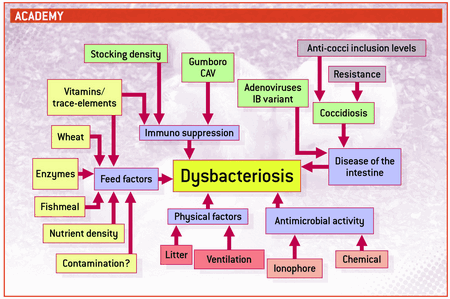
Immuno-suppression
This can be the result of viral diseases such as Mareks and Gumboro, among many others. Therefore, it is important to control these disease challenges, when appropriate, driven by field challenge/risk and effective vaccination programmes.
Concurrent disease of the intestine
It is well known that some infectious bronchitis (IB) variants have gut replication phases that can result in damage to the intestinal cells, as can coccidiosis challenge. Any damage to intestinal cells, despite the initial insult, can then upset the bacterial balance allowing less than desirable bacteria to multiply, resulting in a loss of intestinal integrity. Biosecurity and a solid anticoccidial control programme are critical to controlling these challenges.
Antimicrobial activity
The use of any product which has an effect on bacteria can affect the natural micro-flora of the intestine. This is one of the reasons why it is preferable to use “narrow” spectrum products rather than “broad” spectrum products. For example, the treatment of a respiratory E coli infection with amoxicillin (a broad spectrum antibiotic) will affect the bacteria within the gut. Even although this can be the ideal product for E coli, it can have subsequent negative effects on the intestinal micro-flora. The end result is an upset of the bacterial population and thus dysbacteriosis.
Physical Factors (Environmental)
Litter contamination and condition can support bacteria and thus act as a reservoir of infection. Poor clean outs and inadequate turn-around times can only serve to challenge the birds further. Many diseases are successful due to their ability to persist within the environment.
Two fine examples of this are clostridial disease and coccidiosis. Clostridia can form spores and survive for long periods, even in some disinfectants, to infect chickens at a later date. Coccidiosis oocysts (eggs) can also survive for very long times in extreme conditions in a similar way.
Feed Factors
Despite chickens being omnivorous (meat and plant eating), current legislation forces them onto vegetarian diets. Therefore, the role of the nutritionist is critical in formulating the diets correctly, thus ensuring that the broilers can utilise what they are fed. If just one ingredient, such as an enzyme, is incorrectly mixed or applied, it can have devastating consequences to intestinal integrity.
Recognising gut problems
Good intestinal integrity is recognised to be a lack of inflammation and no excessive secretions within the intestinal tract. On post-mortem examination, this can be demonstrated by a lack of watery contents and mucus through the digestive tract. There should be no inflammation or evidence of disease.
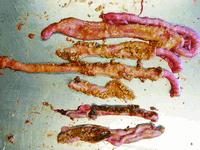
Good Intestinal Integrity
Intestinal contents are not excessively watery. There is no mucus evident along the tract and the intestine demonstrates excellent tone by curling round on itself when opened. On the other hand, a loss of intestinal integrity can be demonstrated by an increase in one, or more, of many undesirable factors such as excessive wateriness of the contents, inflammation and thinness of the gut wall.
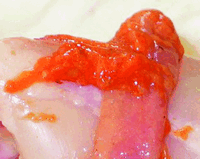
Excessive production of mucus
Mucus is produced by cells in the intestine, in response to irritation. It is a normal mechanism in an attempt to control infection. Unfortunately, mucus can aid the proliferation of some nasty bacteria such as Clostridium perfringens that use it as a source of food. This is the cause of necrotic enteritis and also one of the microbes involved in dysbacteriosis.

Inflamed Peyers Patch
Peyers patches are collections of immune cells along the intestine. They are important collections of cells that fight disease. When exposed to an insult, these patches become raised and reddened, indicating an active immune response.

Feed Passage
Feed that is undigested is not utilised by the broiler, therefore performance will suffer. This is seen in cases of dysbacteriosis, where droppings contain undigested feed indicating poor function of the digestion process. It may be that food is passing through the gut too quickly due to an upset.
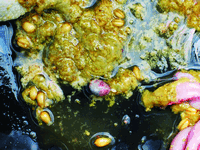
Excessive watery contents
When contents of the intestine become watery it is a result of excessive secretion from the digestive tract or an osmotic effect (draws in water from the gut lining) of the diet due to formulation. Excessive secretion can occur when the cells lining the gut are damaged by infection or toxins. This can also occur when poor ingredients are used or electrolyte balances are incorrect in the feed.
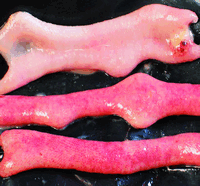
Inflammation of the gut lining
Inflammation is a normal response to an insult. The body increases blood supply to the affected area in an attempt to deliver immune cells and antibodies to fight any infection. This can result in excessive secretion of fluids into the intestine. Here, a normal section of gut is shown at the top as a comparison which appears pale compared to the inflamed portions.
- Barrie Fleming is a qualified vet and the senior veterinary adviser at Elanco Animal Health. Next month, he takes a look at how to improve gut health.
